Brighton and Hove
by Kay Sexton
"Brighton looks like a town that is helping the police with
their enquiries," so said Keith Waterhouse and it's true.
Whether you love or loath Brighton, it has the raffish yet
furtive air of a spiv with dirty postcards for the lads in one
cashmere pocket, and silk stockings for the ladies in the other.
She is a mass of contractions: kiss me quick hats and Victorian
architecture, elegant Regency terraces inhabited by tattooed,
dreadlocked art students and the two piers facing each other over
the stoniest beach in the United Kingdom. It's not even one
town, but two. Bustling Brighton has been inextricably joined to
staid Hove in a marriage of convenience that matches the marriage
that caused Brighton to come to prominence in the first
place.
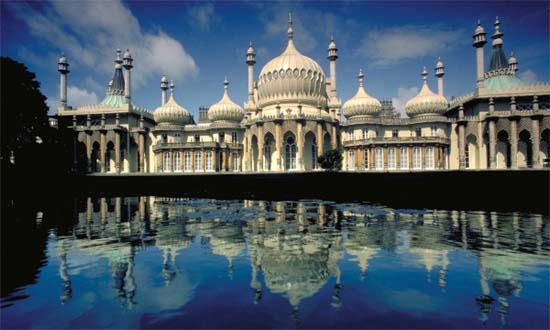
The old fishing village of Brighthelmstone became Brighton
because of the Pavilion -- that louche but exhilarating oriental
palace built by John Nash for his patron the Prince Regent,
George IV. Born Prince of Wales in 1762, George IV was the
oldest son of George III. He rebelled against his strict
upbringing, embarking on a life of drinking, womanising and
gambling that scandalised the country and got him sent out of his
father's sight -- Brighton, and the Pavilion, are the result of
that removal.
George IV -- known familiarly to the country as 'Prinny' --
enjoyed a succession of passionate love affairs and two
marriages. In 1785 he secretly wed Catholic widow Maria
Fitzherbert and in 1795 entered into a disastrous official union
with Caroline of Brunswick. George's complicated personal life
is defined by the fact that an underground passage leads from the
Pavilion to the nearby house occupied by Mrs Fitzherbert. George
became Prince Regent in 1811 when his father was thought to be
mad, and was crowned in 1820.
The Royal Pavilion's lavish interiors combine Chinese-style
decorations with magnificent furniture and furnishings. Gilded
dragons, carved palm trees and imitation bamboo staircases
contribute to the buildings unique style which mixes Asian
exoticism with English eccentricity. Daring and inventive
colours feature throughout, and there are many original items on
loan from Her Majesty the Queen. The restoration of the Royal
Pavilion was begun when the Palace was purchased from Queen
Victoria by the town of Brighton in 1850. After many decades of
neglect, somewhat as a result of Victoria's own disapproval of
Prinny's madcap lifestyle, a programme of restoring the stonework
and structure of the Pavilion began in 1982, which took over a
decade and cost £10 million. The programme to reinstate the
interior decorative schemes approved by George IV in the early
1820s still continues today.
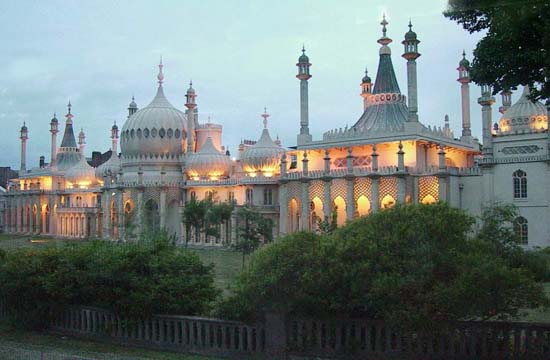
Architect John Nash conceived the Royal Pavilion and gardens
as a whole. The gardens reflect the great revolution in landscape
gardening that began in the 1730s, formal layouts, straight
lines and symmetrical shapes were replaced with curving paths,
natural groups of trees and shrubs, and picturesque views.
Nash's scheme was utterly destroyed in the 19th century by a
tarmac road but recent restoration has brought the grounds as
closely as possible back to Nash's 1820s vision. Plant species
and varieties have been selected using the original lists of
plants supplied to George IV.
The Old Steine was the social centre of the town in Prinny's day.
Originally an open grassy area with a stream running through it,
fishermen traditionally laid out and dried their nets there.
When fashionable visitors began to travel down to Brighton in the
late 18th century, either to keep themselves in the Prince
Regent's favour, or because London had become too hot with
gambling or dressmakers debts for the 'fast set' Old Steine
became the fashionable centre. The very first building built on
the eastern side of the Steine in 1760 was a circulating library
and this was the social hub of Regency society. When a
fashionable Regency visitor, came to the town towards the end of
the 18th century, the first thing he or she did was visit one of
the circulating libraries Upon payment of an agreed sum the
visitor would be allowed to sign on in the Master of Ceremonies'
book. The Master of Ceremonies made sure that the balls that were
being held in the Castle Inn didn't clash with balls that were
being held in rival establishments, like the Old Ship. He made
sure that each new visitor's name was known to other visitors in
the town and this meant the fashionable set would know to call
upon new arrivals or invite them to the various social
activities.
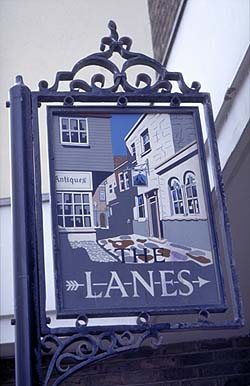 While modern Brighton may not be so socially
organised, it is still a radical social centre: the city has a
large gay community, mainly based in the Kemptown area of the
city, and is home to two universities, the University of Sussex
and the University of Brighton. This thriving and diverse gay
scene ranges from leather bars, to country and western line
dancing, pink parlours to techno clubs, and has long been known
as the British number one gay seaside resort -- so much so that
Kemptown is affectionately locally re-titled Camptown. Pride
Brighton takes place every August and is one of the biggest,
brashest and best natured Gay Pride events in Europe. While modern Brighton may not be so socially
organised, it is still a radical social centre: the city has a
large gay community, mainly based in the Kemptown area of the
city, and is home to two universities, the University of Sussex
and the University of Brighton. This thriving and diverse gay
scene ranges from leather bars, to country and western line
dancing, pink parlours to techno clubs, and has long been known
as the British number one gay seaside resort -- so much so that
Kemptown is affectionately locally re-titled Camptown. Pride
Brighton takes place every August and is one of the biggest,
brashest and best natured Gay Pride events in Europe.
Along the seafront, the area occupied by the original fishing
village has become The Lanes -- a collection of narrow alleyways
now filled with a mixture of antique shops, restaurants and pubs.
The name derives from 'Laine', which was apparently a unit of
Anglo-Saxon field measurement. Highlights for any visitor to
Brighton should include The Black Lion pub, which looks ancient,
but is in fact a reconstruction of part of one of the oldest
brewery buildings in the world. Tradition claims the Black Lion
brewery was established in 1546 by Deryk Carver, a Flemish
immigrant. Carver went on to become the first Protestant to be
martyred under Mary I. He was burned in a barrel outside the Star
Inn at Lewes in 1555, apparently flinging his Bible into the
crowd in defiance. The brewery, complete with a 54-foot well
that delivered sweet water for use in beer-making, was owned and
run by various brewers during the nineteenth and twentieth
centuries, but fell into disuse in 1968 and was demolished. The
current pub was built in 1974 as a replica of part of the
brewery. The reconstruction is faithful to Carver's own plans
and even uses many original flints and slates.
Visitors who prefer social history to that of royalty might like
to visit Frederick Gardens, a row of typical Sussex houses. At
first these plots were allotments but as the city grew outward,
the owners of the allotments built homes progressively from No 1
onwards. If you examine the cottages you can see they are all a
little different. At one time Frederick Gardens housed a foundry
and many of the workers lived in these small homes -- about
halfway down the street is one cottage with a basement and it is
claimed that is where the foreman lived. This part of the Lanes
was considered a very dubious area and many now sought-after
properties were once brothels. Frederick Gardens cottages may
look quaint but local residents can be a little cynical about
their charms; many have battled for decades with rising damp
coming through the "bungaroush" -- a construction
method based on cementing found objects from the beach together
to form a wall.
Queens Park
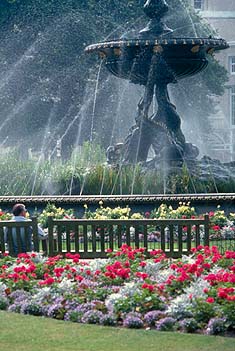 In the early
part of the 19th century there were spas all over Europe. There
was just one problem - Brighton lacked the natural water
necessary for a spa. There was a good sweet-water spring and spa
in St.Ann's Well Crescent Gardens in Hove but this was too far
away for the 'fashionable folk' in Brighton. With typical
bravado, Brighton found a solution no other town would dream of
-- it made artificial natural water. Frederick Struve, a
research chemist from Saxony, had invented a machine that
reproduced the characteristics of natural mineral water using
chemicals and in 1825 he opened the pump room of his 'German Spa'
in Queens Park. The Brighton Gazette provided an eyewitness
description of the site, "The building consists of a large
handsome room fifty or sixty feet in length, and of proportionate
breadth and height. A fine flight of steps lead to the noble
saloon, on which are placed Ionic columns, supporting a portico
in the purest Grecian taste. On the side of the Saloon opposite
the entrance runs a counter, behind which are ranged cocks that
supply different kinds of waters." In the early
part of the 19th century there were spas all over Europe. There
was just one problem - Brighton lacked the natural water
necessary for a spa. There was a good sweet-water spring and spa
in St.Ann's Well Crescent Gardens in Hove but this was too far
away for the 'fashionable folk' in Brighton. With typical
bravado, Brighton found a solution no other town would dream of
-- it made artificial natural water. Frederick Struve, a
research chemist from Saxony, had invented a machine that
reproduced the characteristics of natural mineral water using
chemicals and in 1825 he opened the pump room of his 'German Spa'
in Queens Park. The Brighton Gazette provided an eyewitness
description of the site, "The building consists of a large
handsome room fifty or sixty feet in length, and of proportionate
breadth and height. A fine flight of steps lead to the noble
saloon, on which are placed Ionic columns, supporting a portico
in the purest Grecian taste. On the side of the Saloon opposite
the entrance runs a counter, behind which are ranged cocks that
supply different kinds of waters."
Customers could obtain the waters of Karlsbad, Kessellbrunnen on
Ems, Maienbad, Pyrmont and other continental Spas. These
curative waters received considerable patronage from the upper
classes. In the first season there were over three hundred
subscribers to the Spa and in 1835, ten years after opening,
Struve obtained the patronage of King William IV and immediately
renamed his property the 'Royal German Spa'. Perhaps wary of
overselling his product, Struve maintained that most of his cures
would have no immediate effect but would take about a month
before his customers would duly be restored to their full heath
-- by which time he could reasonably expect them to have left
Brighton. There were contemporary complaints that the pump room
was not big enough for the number of people using it and that the
carriages waiting in the road down to the sea ran into three
figures.
Also in Queen's Park is the Pepper-pot -- this odd little folly
was built to house the now demolished Attree Villa's villa's pump
and water tank. It supplied water by force from the pressure of
water contained in the large tank in the top of the tower. In a
long and typically Brightonian fashion, the building was
subsequently used for printing and publishing the Brighton Daily
Mail, then as an observation tower in the Second World War, as a
scout headquarters, an artist's studio, and finally as a public
convenience. Today it is not used at all.
Brighton has two Clock towers, one in central Brighton and the
other in Queen's Park, the former, though recently restored, is
not quite back to its full Victorian glory because the ball at
the top of the Tower once used to rise to the top of the pole and
then come crashing down on stroke of the hour. The mechanism was
disabled because the vibrations were destroying the structure.
The rather fine bas reliefs of Victoria, The Prince Consort, the
Prince of Wales and Princess Alexandra are worth a visit, and you
can imagine how impressive the edifice must have been when it was
in full working order.
In a typical fashion, the city has begun to invent its own
traditions, and along with Pride and the Beach Party, Brighton
has 'Burning the Clocks'. This contemporary community festival
is a "new tradition" first organised in 1993. It
celebrates the shortest day of the year and therefore usually
takes place on the winter solstice. The centrepieces of the
celebration are huge lantern costumes made from withies (willow
canes) and tissue paper and brilliantly lit from within. The main
costumes are made by artists from Same Sky, a local community
arts organisation, but thousands of people make their own
lanterns and join the procession. The parade is accompanied by
live music from local bands. It ends on the seafront. Here the
'burning of the clocks' takes place when the lanterns are burnt
on a bonfire and a spectacular fireworks show takes place. With
ceremonial splendour the old year is burnt along with the
costumes and lanterns and fireworks make way for the New Year and
the coming of spring. Although the theme for these lanterns
changes every year, all of the costumes are supposed to include a
clock-face to represent the passing of time.
In 1872 Brighton possessed one of the wonders of the modern world
-- the Aquarium. In fact there were only two such constructions
in Europe and the other was built in Rome in 1874. The typical
chequered history of Brighton's buildings has given the Aquarium
a range of peculiar tourist attractions over the centuries,
including a chimpanzees tea party, but now it is restored to its
original splendour and purpose and is well worth a visit, and not
just for the fish. The Sea Life Centre as it is now called,
displays a range of fish in the original tanks in the main hall
-- while you're examining the Giant Japanese Crabs and Piranha
cast your eyes up to the top of each pillar in the central aisle,
every one has a different and anatomically accurate (in 1872)
marine creature decorating it. There is rumoured to be a tunnel
connecting the Aquarium with the Pavilion too, although nobody is
quite sure what Prinny used it for!
On the Water
It is a tragedy that no boats can land on Brighton's beach,
except the one beautifully restored Brighton-rigged fishing
vessel maintained by Brighton Fishing Museum. This unique
tribute brings the history of Brighton's oldest industry alive.
The centre-piece of the museum is a full-size clinker-built
fishing boat, built in Sussex following traditional methods used
for many generations. As well as the 27ft beach boat, there are
prints, photographs and memorabilia of Brighton seafront life
from the Regency days to the post-war boom in pleasure boat
operations. A computer archive is also available which can be
consulted for more information about the local fishing and
boating fraternity. Above all the museum operates a 12 seater
passenger boat, Skylark, off the beach in fair weather during the
summer months. This is a trip not to be missed -- Brighton boats
had a unique feature, each huge iron keel had a large hole in it,
through which metal cable was threaded at low tide to haul the
boats up the shingle. As a result the boats were familiarly
known as bum-first launchers! There are also two shellfish
stalls, a smokehouse and a smoked fish shop within yards and any
conversation you strike up is likely to be with one of Brighton's
few remaining fishermen, a living resource of fact and legend
about the city's original industry.
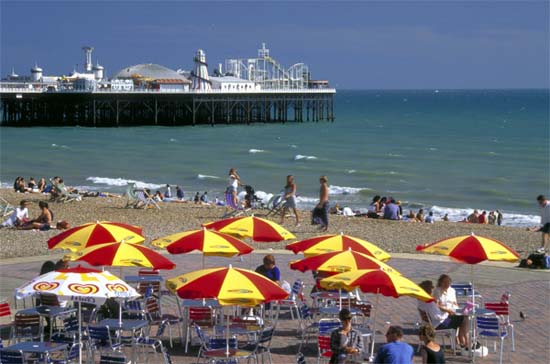
However, a mile or so along the beach is the largest Marina in
the UK. Brighton Marina is a hive of activity offering extensive
marine services, a lively yacht club, restaurants, a cinema,
bowling alley, casino and a health and fitness club. The new
Waterfront development includes a hotel and numerous shops, bars
and restaurants. Several French Marinas are within easy reach --
the closest, Fecamp, just sixty five miles away, is an attractive
town with a busy fishing port. Other destinations to choose from
include the picturesque Honfleur (ninety miles away) or Dieppe
(70 miles). Alternatively, cruise west along the South Coast to
Chichester, Southsea and Port Solent.
The somewhat schizophrenic Brighton is sometimes known as 'London
by the Sea' because of its lively atmosphere and cosmopolitan
nature and also because of the large number of visitors from
London. Note that many Brighton residents, being not short on
nerve, refer to London as 'Brighton by-the-land'! Brighton is
renowned for its lively music scene, having spawned a number of
successful bands in recent years, not least Fatboy Slim and The
Levellers. It supports a number of record labels, including
Skint Records and LOCA Records and a range of celebrated clubs.
Brighton is equally well known for its large number of bars --
you can drink in a different bar on each day of the year. The
city has also over fifty churches, so you can repent your drunken
sins in a different one every week of the year too.
For those with a literary or celebrity hunting preference,
Brighton offers the chance to see the McCartneys and the Fat Boy
Slims, the Eubanks and Julie Burchill eating out in the city or
shopping in The Lanes. Literary uses of Brighton abound: Graham
Greene's Brighton Rock, Wilde's The Importance of Being Earnest
(Jack Worthing was abandoned in a handbag in a cloakroom at
Victoria Station on 'the Brighton line') and Patrick Hamilton's
West Pier are just a few. In addition, every Brighton bus has a
famous Brighton resident's name in the front, so you can spend
the day travelling through the city from Aubrey Beardsley to
Dusty Springfield, taking in King Charles II and Lord Olivier on
the way.
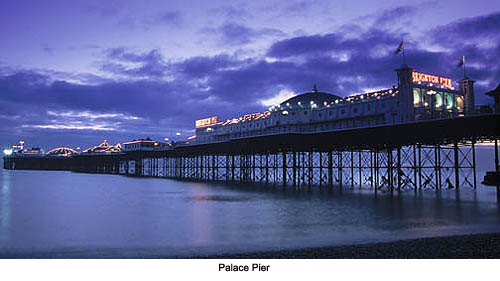
The Booth Museum of Natural History offers over half a million
specimens. Natural history literature and data extending back
over three centuries are housed in this fascinating museum.
Exhibits include hundreds of British birds displayed in recreated
natural settings, plus butterflies, skeletons, a whale and
dinosaur bones. The new Discovery Laboratory offers interactive
displays exploring the Booth's collections.
The Brighton Museum & Art Gallery is part of a regeneration
scheme aiming to reinvigorate the cultural centre around the
Royal Pavilion estate. The Museum houses nationally and locally
important design collections. The entrance in the Royal Pavilion
gardens has a spacious foyer and shop and a very good tea room
upstairs. Hove Museum, on the other hand, is set just outside
the heart of the city and has one of the most magical exhibitions
for the young or young at heart -- an interactive childhood toy
display with trains running under the glass floor. The rooms
that detail the development of the motion picture industry are
superb, and the rolling display of the earliest ever films allows
Brighton and Hove to lay claim to being the birthplace of
cinema.
East Sussex has more to offer than its seaside towns, however.
Almost two thirds of the county is contained within Areas of
Outstanding Natural Beauty. There are five country parks, and the
South Downs Way long-distance path provides superb walking
through ancient woodlands and across the rolling hills of the
South Downs. Small villages are dotted along the river valleys,
and the area is rich in prehistoric remains, the best known of
which is the enigmatic Long Man of Wilmington hill figure.
More Information:
We regret that we no longer have the resources to maintain up-to-date links and/or hours and pricing details for the various sites and attractions listed on this website. For more information about the location(s) listed above, please use your favorite search engine or visit Wikipedia.
Kay Sexton spent more than a decade as a house writer for
charitable/environmental organisations worldwide. Her publication
credits range from H&E International to France
Today to the World Water Forum Annual Report. She is
also a Jerry Jazz Fiction Award winner with columns at moondance.org facsimilation.com. Her short story
"Domestic Violence" was runner-up in the Guardian fiction contest
and her work appeared in seven anthologies in 2004. She teaches
writing and business communications.
Article © 2006 Kay Sexton
Photo credits: Pavilion (top), Lanes, Fountain, Beach courtesy of Britainonview.com; Pavilion (center) courtesy of Wikipedia.org; Palace Pier courtesy of Brighton Tourism Board.
|
